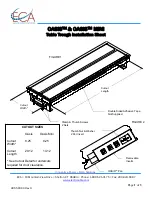
INSTRUCTIONS
GEH-29068
Supersedes GfH-29NA
and GfH-2903A
DISTRIBUTION SURGE ARRESTERS
CAUTION: THE
EQUIPMENT
COVERED
BY
THESE INSTRUCTIONS SHOULD BE INSTALLED
AND SERVICED ONLY BY COMPETENT PER
SONNEL FAMILIAR WITH GOOD SAFETY PRAC
TICES.
THIS INSTRUCTION IS WRITTEN FOR
SUCH PERSONNEL AND IS NOT INTENDED AS A
SUBSTITUTE FOR ADEQUATE TRAINING AND
EXPERIENCE IN SAFE PROCEDURES FOR THIS
TYPE OF EQUIPMENT.
GENERAL
The nameplate rating should be checked to ascer
tain that the maximum circuit line-to-ground volt
age under any condition of operation, including fault
conditions, will not exceed the voltage rating of the
arrester.
Application of higher-than-rated power
voltages may result in the failure of the arrester.
EffiCient operation of the lightning arrester re
quires a permanent low-resistance ground
The
best protection is obtained by connecting the arrester
directly across the line and ground terminals of the
apparatus being protected, using a common ground
connection for both apparatus and arrester.
If
this
is not physically possible, the arrester should be so
connected that its grounding resistance does not ex
ceed five ohms.
INSTALLATION
CAUTION:
CARE SHOULD
B
E
TAKEN
IN
HANDLING
ARRESTERS TO AVOID
BRE
A
K
AGE
.
The arrester preferably should be mounted ver
tically and installed as close as possible to the ap
paratus being protected. Line and ground connec
tions should be short and direct. Line and ground
terminal nuts or bolts should be tightened firmly on
their respective leads, but with no more than
15
lb-ft torque.
The arrester should be clamped securely in its
hanger and in a location where it will not be sub
jected to sustained vibration.
Fig.
1.
Distribution arrester with disconnector.
Fig.
2.
Distribution arrester, externally gapped.
Arresters may also be mounted horizontally.
However, a slight inclination with the line end ele
vated may be desirable.
NOTE: Precautions to be taken in instal
ling direct-connected arresters are shown
in Fig.
3.
These instructions do not purport to cover all details or variations in equipment nor to provide for every possible contingency to
be met
in connection with
installation, operation or maintenance. Should further information
be
desired or should particular problems arise which are not covered sufficiently far
the
purchaser's purposes, the matter should
be
referred to the General Electric Company.
www
. ElectricalPartManuals
. com




















